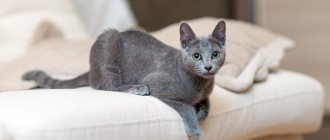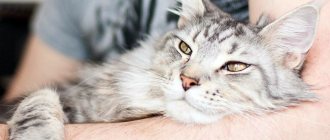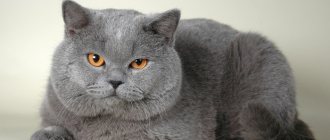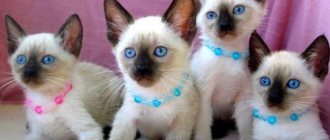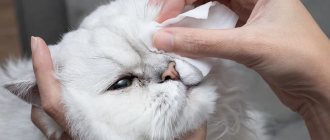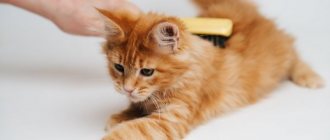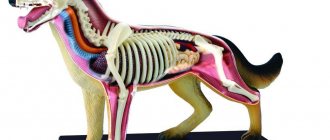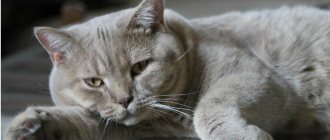The Siamese cat is a popular short-haired breed with a recognizable point color. Unique beauty is combined with sociability and intelligence. A good companion for those who value open expression of feelings and constant connection with their pet. These talkative cats will not let you get bored and will participate in all family activities.
| Breed | Siamese cat |
| Type | Siamese-oriental (eastern) group |
| Country of origin | Thailand |
| Coat | Shorthair |
| Lifespan | 15 – 25 years |
| Kitten price | 8000 – 35000 rubles |
History of the origin of the Siamese breed
The Siamese cat is one of the oldest and most famous cat breeds. Despite this, the origin of Siamese cats is still considered a mystery.
- The manuscript "Book Poems about Cats", dating back to 1350 - 1700, discovered in ancient Siam (modern Thailand), describes a pale cat with a dark coloration of the face, paws, ears and tail.
- According to legend, the Siamese were considered sacred. When a member of the royal family died, his soul was possessed by a Siamese cat, which then lived in the temple in luxury with monks and priests as servants. The theft and killing of a Siamese cat was punishable by death.
- Uncontrolled crossbreeding of Siamese in the 19th and 20th centuries led to cats no longer meeting the breed standard. Modern Siamese have become thinner and have acquired a characteristic triangular muzzle.
Subsequently, Siamese cats quickly became popular in different countries. This breed was first seen in Europe in 1871 at the London Cat Show. In 1879, a Siamese cat was given to the wife of the US President. The Siamese Cat Club was formed in 1901 in Great Britain, and the Cat Fanciers' Association (CFA) recognized the breed in 1906.
Related breeds:
- Oriental cat.
- The Balinese cat is a semi-longhaired Siamese cat.
- Burmanskaya.
- Thai is a restored Siamese breed according to the old type standard.
- The Himalayan is a long-haired breed developed by crossing Siamese and Persians.
Differences between Siamese and Thai breeds
Varieties
Breeders strive to improve the breed, and other breeders consider it their duty to preserve the Thai Siamese cat breed in its original form at all costs. Therefore, today the classification distinguishes two cat breeds: Thai and Siamese, which differ in some constitutional features.
Siamese appeared in Russia in the 60s of the last century, and our Soviet breeders sought to improve the breed. But since there were few of this breed, it was necessary to cross with closely related individuals and with outbred cats.
The result was kittens with pronounced genetic abnormalities: stubby tails, severely squinted eyes and an aggressive disposition. But the breeders did not give up, and as a result, genetic deviations were eliminated, and the character became softer and more flexible.
- Balinese (Balinese) is a breed of cat with semi-long hair. It was bred by American breeders and registered in 1928 as a result of a mutation when crossing two short-haired individuals. After many years of work, the breed was recognized in 1965, and in 1970 it received the official name - Balinese.
- The Burmese is a short-haired, brown-colored breed with yellow eyes, bred from two breeds: the Wong Mau and the Siamese. In 1930, California breeder Joseph Thompson received a chocolate-colored Wong Mau cat from Burma (now Myanmar, a country bordering China, Laos and Thailand). In 1936, the breed received independent status.
- The Himalayan is a blue-eyed breed with very long, beautiful hair, obtained by crossing a Siamese with a Persian. Very similar to the Persian, but has blue eyes and a Siamese-like color. In Europe it is called Persian color point.
- The Snowy Cat is a cream-colored breed with glasses around the eyes. Occurred by crossing a Siamese and a two-color American cat, obtained in 1960.
- The Tonkinese is a mix of Thai and Burmese cats. The breed has taken something in between the two breeds, but the most attractive thing about it is its sea-green eyes. It was registered in 1960.
- Javanese (Oriental breed) - distinguished by a very long and slender figure with long legs and tail, large ears, two-colored. The breed was recognized in 1977 in the USA.
- Thai is an old type breed preserved by breeders.
Description of the Siamese breed
Let's look at the appearance and character of Siamese according to the breed standard.
Standard
Siamese cats are well balanced, boasting an athletic, flexible body and elegant, slender legs.
The breed standard for the modern Siamese cat assumes:
- Body: Elongated, tubular and muscular. A typical Siamese cat has a total height of 20-25 cm and a body length of 29-36 cm, with a body weight of 4-5 kg.
- Head: Straight profile with a strong chin and a pleasant, even bite. The head forms a perfect triangle from the tip of the nose to each tip of the ear. The neck is long. The eyes are almond-shaped, bright blue, and the ears are large, wide, located closer to the head.
- Limbs: The cat's hind legs are longer than her front legs, which adds to her athletic and graceful appearance. The paws are oval shaped and small. Thin tail.
- Coat: Short, shiny, fine coat without undercoat that lies close to the body.
Today, there are over 20 varieties of Siamese cat colors all over the world, and the most famous of them are:
- Seal point (brown or cream), with a cream-colored body and dark brown pigments on the nose and paws. It is believed that this was the original color of the breed when it was first exported from Siam (Thailand).
- Blue Point (blue) - the body is snow-white with a bluish tint, as well as a gray nose and paws.
- The Red Point is a white body with red (apricot) pigments on the nose and paws.
- The Caramel Point (light cream) is considered a hybrid due to a complex breeding process, with very light and pink pigments on the nose and paws.
- Chocolate point (black). The body is cream or milky in color, and the pigments on the points can range from chocolate to black.
- Cinnamon point (ivory). The body is ivory-colored, like a Chocolate Point, but the markings on the nose and paws are pinkish-brown.
Photos of colors
Seal Point
Blue Point
Red tabby point
Caramel point
Chocolate Point
Cinnamon Point
Characteristics and breed standard
The felinological association TICA gives the following description of the Siamese cat breed:
- Head. Elongated wedge-shaped with close-fitting fur and ears. A slight presence of “cheeks” is allowed only in adult purebred breeding males.
- Eyes. Medium size and eastern cut. They are spaced quite narrowly - the distance between them is equal to the length of one eye. The color is bright from blue to sapphire - all shades of blue. Green tones are not allowed.
- Ears. Quite large, located at an angle and extend beyond the cheekbones. The fit as wide and low as possible is considered a plus.
- Neck. Long, slender, graceful, but muscular.
- Body. Long and graceful, yet strong and muscular without being massive. Equal width along the entire length.
- Paws. The skeleton is light. Long and thin with narrow and elongated pads. Muscular. The rear ones are higher than the front ones.
- Tail. Thin throughout its considerable length. The tip is tapered and pointed.
- Wool. Short, close to the body, shiny.
- Colors. Color point is required for any color. Points are located on the face (“mask”), ears, paws, and tail.
The number of acceptable colors is twelve.
- Weight. The male is larger than the female. Average weight is from three to five kilograms.
- Only intrabreed matings are allowed.
- Flaws. Spots darker than the main background on the chest and abdomen. Darkening the main background. Poor contrast.
Disqualification:
- No color point.
- Any eye color other than all shades of blue.
- White markings and white toes.
- Strabismus.
- Kinks and knots on the tail..
- Malocclusion.
- Polydactyly.
- Aggressive behavior.
Character of Siamese
Siamese are known for being one of the most intelligent and vocal cats in the world and will happily spend time with their owners. Siamese cats are affectionate with domestic cats, however, they can be demanding and suspicious of strangers. Many people say that their Siamese pets greet strangers at the door and go through some kind of approval process before visitors enter the house.
At the same time, Siamese cats are very active and love active games with toys. When it comes to training, they do not have any special exercise needs because Siamese cats are very active and playful in their own right.
They quickly get accustomed to the litter box and scratching post; the main thing is not to shout or force the cat to do anything. Siamese are quite proud and can become stubborn from such treatment. You can even toilet train them if you start training them when they are young.
You should not get a Siamese cat if you are often away from home. The pet will get bored and entertain itself in any of the available ways.
The stereotype about the evil character and vindictiveness of the Siamese, as a distinctive feature of the breed, originated in the USSR. The price of a purebred Siamese cat was high, so we usually received rejected kittens with squints, creases in the tail and abnormalities.
How much does a Siamese cost?
When new breeds from the Siamese began to be developed in the 60s of the last century, having such a cat in Europe and America was considered a sign of material well-being and sophistication. An actress appearing in public without a Siamese did not have a chance to get on the pages of gossip columns.
- Now the cost of this Siamese cat is not so high, and the average family can purchase it.
- The price for one show kitten varies from 200 to 300 dollars.
You must buy from a trusted nursery and provide documents and a pedigree confirming the kitten’s pedigree.
Health
With proper care and nutrition, the average lifespan of Siamese cats is 15-25 years.
They may also have problems with progressive retinal atrophy, which can lead to poor vision and even blindness. Glaucoma and strabismus are also common among eye diseases.
This breed is more prone to lung infections than others. The most common condition is asthma, which causes inflammation and narrowing of the lungs' airways.
These cats are known to have very sensitive stomachs. In addition, Siamese cats may have problems with the heart, kidneys and liver.
Nutrition
Fluffy animals can eat anything that is edible; their stomachs are adapted to everything.
But still, it would be better to feed your pet dry food.
They contain everything necessary that the animal’s body requires.
How much food to give is determined individually.
But, there are rules for all types of Siamese:
- Up to six months you need to feed four times;
- Up to one and a half years three times;
- Then feed twice.
This is all you need to know about the nutrition of fluffy Siamese cats. But if this is not enough, you can seek the help of a specialist.
Breed card
| Characteristics of a cat | Notes | |
| General information | An ancient cat breed known for its pointing color, playfulness and ringing voice. Extroverts by nature | Modern Siamese are the result of restoring the standard of an ancient breed. And those yard cats, which in Russia are usually mistaken for Siamese, are representatives of the Thai breed |
| Character | Siamese require their owner's attention constantly. They have an affectionate nature and are quick-witted, but can be stubborn | Purchase various toys in advance so that your pet always has something to occupy himself with. The best solution would be to purchase a play set for cats |
| Appearance | A medium-sized cat with a slender, athletic body, an elongated wedge-shaped head, large ears, and blue or blue eyes. Kittens are born completely white. Points (areas of dark fur) develop as the dog matures, with the sides usually being the last to darken. The final color is formed by 2 years of age. | Strabismus and creases in the tail are a defect in the breed. If you are offered a kitten with green or yellow eyes, then this is not a Siamese, but perhaps an Oriental. |
| Behavior at home | Active breed. They love to climb and play. Very talkative, especially cats during mating season | Siamese are sexually horny cats, so their puberty begins earlier than other breeds. You can castrate your pet at the age of 4-5 months. |
| Care | Minimal maintenance as there is no undercoat. Combing once a week. A scratching post is required | |
| Health problems | Among the congenital defects there is strabismus. Modern Siamese have problems with tail kinks and respiratory problems | Food allergies to cow's milk are common |
Advantages and disadvantages
Siamese have a lot of advantages and disadvantages:
| pros | Minuses |
|
|
Before purchasing a pet, it is advisable to determine whether the animal is suitable in temperament and habits.
Care
They are incredibly clean and don't shed much, so caring for them is not particularly difficult.
Wool
Even though Siamese cats have short hair, they need to be brushed weekly. Many fans of this breed recommend small rubber brushes. You need to comb in the direction of hair growth.
Most Siamese cats are very clean and clean themselves well, so you can bathe them no more than 2 times a year. However, when they are very dirty or have gotten into something sticky, they may need a little help.
Advice! Place a rubber mat in the sink or bathtub to prevent your cat from slipping.
Nutrition
In addition to basic veterinary care such as vaccination compliance and regular checkups, proper nutrition is important. Providing a proper diet can help prevent health problems in your pet later in life.
Advice! Don't forget to change the water and wash the bowls daily!
There are two options for feeding your pet: natural food and industrial food.
Natural nutrition
- Basic nutrition – animal proteins:
- Lean meats (chicken, rabbit, lean beef and turkey).
- Sea fish and seafood (tuna, cod, shrimp) - as a source of healthy fats and taurine.
- Eggs (preferably quail) – no more than once a week.
- Beef liver and offal - tripe, udder, lips, chicken necks.
- Carbohydrates and fats
:- Fermented milk products - cottage cheese, ryazhenka kefir, yogurt without additives.
- Vegetables and greens - zucchini, carrots, spinach, pumpkin, broccoli, peas, beets.
- Porridge – buckwheat, millet, oatmeal, rice.
- Linseed oil.
- Vitamins – additional vitamin complexes are required for natural nutrition. Main additives: taurine, tetravit, calcium and yeast as a source of B vitamins.
Important! Red meat and liver can darken light fur, so you should not make such foods the main food for show cats.
Industrial feed
The basic rule is not to feed your pet economy-class food. The ideal option would be brands from the super-premium and holistic categories. We have previously compiled ratings for dry and wet cat food.
Recommended brands:
- Orijien Fit & Trim.
- Acana Light & Breed.
- Go Natural.
- Eukanuba Sterilized.
- Bosch Sanabelle.
- Royal Canin “Sterilized 37”.
Sometimes cats are allergic to grains, cow's milk and poultry. In such cases, it is necessary to switch to grain-free lines such as Natural & Delicious, which are free of rice, corn and chicken.
Adult pets with certain diseases (diabetes, urolithiasis, renal failure and heart pathologies) are transferred to specialized veterinary nutrition. A good line of medicinal foods is represented by the Hill's Prescription Diet brand.
Vitamin-mineral complexes are not needed, because manufacturers necessarily include all the compounds necessary for the body in the feed.
Caring for ears, eyes, teeth and claws
- If possible, you should brush your cat's teeth 2 times a week. We revealed all the nuances of this simple procedure in this article.
- The almond shape of the eyes allows pus and tear fluid to accumulate in the corners, so be sure to wipe your eyes with a damp cotton pad as needed.
- Ears should be wiped with a barely damp cotton pad once a week. If you notice black spots, crusts and an unpleasant odor, take your pet to the doctor. The most common cause of such symptoms is ear mites, which are easily eliminated in the initial stages. If left untreated, it can lead to hearing loss.
A visit to the veterinarian every year is mandatory for keeping a Siamese cat. Examinations provide an opportunity to early detect health problems, including those that may change your cat's care needs. For example, viral diseases, eating disorders, heart and kidney problems.
The frequency of visits to the veterinarian depends on the age of the pet:
- kitten 1-4 months – monthly visits;
- 4 months to 7 years – 1-2 times a year;
- 7-10 years – twice a year;
- over 10 years old - visit every 3 months or more often, as age-related health problems only increase.
Walking your pet
Siamese cats are ideal pets for both apartments and country houses. They are perfectly adapted to travel and trips, because the main thing for these creatures is the presence of their beloved owner nearby. Cats are good travel companions when they are happy. Your job is to figure out how to make their journey comfortable. Bring your favorite bed, litter box, toys, food and litter box.
They can also be easily trained to walk outside in a harness or in a walking carrier.
Feeding
Choosing the right diet for your pet is the main task of every owner. The Siamese cat is particularly prone to obesity, so it needs a special selection of food. You don’t have to choose between natural food and dry food, as they can be combined.
Natural nutrition
Suitable natural products:
- fish;
- boiled beef and chicken should be eaten most often, because excess protein causes darkening of the coat;
- boiled rice;
- egg yolk;
- butter.
It is important to ensure that there is always clean water in the bowl.
Industrial feed
It is better to choose premium-class food. Their composition is tailored to the needs of the cat’s body.
Which ones are suitable:
- Acana;
- Schesir;
- Applaws.
Don’t forget that an active lifestyle, which requires a lot of energy, is very important for the health of a Siamese cat. The cat may often ask to eat, but you should not overfeed it.
How to choose a kitten
When choosing a Siamese kitten, the most important things are its health and pedigree. Therefore, it is imperative to see the kittens’ parents and find out about their general health. Any mention of heart or liver problems in either parent should be noted as these can be passed on to the kittens.
You should also look at the place where the kittens are kept to make sure that they are free of dirt, fleas and ticks. Siamese kittens are social and quite dependent on their parents.
Therefore, kittens should not be weaned from their mother before 12 weeks of age, otherwise they may develop severe anxiety disorders.
You may notice that the kittens are either creamy white or lighter in color than expected. This is fine. The face, paws and tail darken at about 4 weeks of age and continue to darken until the kittens are 1-2 years old. The size of the points directly depends on the temperature of the habitat. The lower the temperature, the more the coat darkens.
That's why newborn kittens, warm from their mother's womb, are white everywhere. Then, as they grow at normal temperatures, the hottest area of their body, around the belly and back area, remains pale while the limbs gradually become darker. And in an adult cat, the general body temperature begins to drop somewhat, and over time the fur darkens more and more.
As for the cost of a kitten , this indicator depends on the following factors: age, pedigree, health status, availability of vaccinations, travel box, toys, etc. Also of great importance is the owner's guarantee that her parents do not suffer from any serious diseases that could be inherited by the kitten.
- The price of a pet-class kitten (pet) is 3000-8000 rubles.
- Breeding class (breeding) – 10,000-15,000 rubles.
- Show class (show kittens) – the price depends on the nursery, from 30,000 rubles and above.
Breeding
If you decide to start breeding a Siamese cat, the first step is to find a healthy male. Of course, the best way to do this is to contact the owner of a nursery near where you live. A Siamese cat owner with a good pedigree will be happy to help you in this matter, as he knows how important it is to keep the blood lines pure and reduce the risk of any hereditary problems.
When choosing a breeding cat for your Siamese breed, consider the following factors:
- Is this the first time your female will be mating? If the answer to this question is yes, then you should think about having an experienced male.
- Have you had all the necessary tests? Before you take your cat for mating, you should arrange a visit to the veterinarian to confirm the absence of hereditary and viral diseases.
- What are you going to do with the kittens? When choosing a breeding cat, you need to make sure that you can sell the kittens in the future.
Pregnancy in Siamese cats is slightly shorter than other breeds - 58-65 days. On average, a Siamese cat gives birth to 4 to 6 kittens. The colors of kittens can be predicted in advance by knowing the recessive and dominant genes for coat colors in both partners.
Siamese catteries in Russia
The Siamese breed is one of the most numerous, so finding a nursery is not difficult at all:
- "Orientville" - Moscow.
- "Siaorimania" - Moscow.
- "Jubatus" - Novocheboksarsk.
- "JUNGLE" - Moscow.
- "Eastward" - Moscow region.
- "EkstaSia" - Yekaterinburg.
Color
The coat color is distributed according to the color-point system (light body with dark color on the limbs: paws, muzzle, ears, tail).
This color is incomplete albinism and is called acromelanism (the location of darker pigment on cold-blooded areas).
Siamese cat kittens are born completely white, but by 5-10 months of age the color becomes complete.
Interesting facts about the Siamese cat
- The color of their coat is determined not only by heredity. This breed has a special modifier gene that prevents the development of pigment in the fur, which leads to albinism.
- Siamese are considered one of the oldest cat breeds in the world.
- Legends say that in ancient times the first Siamese cats were tasked with guarding the royal cup. They looked at him with such intensity that their eyes crossed. For added security, the cats wrapped their tails around the cup, causing them to become permanently bent.
- Siamese cats have appeared in many Hollywood films.
Overall, this is the most affectionate cat breed you will find. She is very smart, obedient and friendly, and also loves and values human communication so much that she is even called a cat-dog.
Appearance of the Siamese
In the photo of a Siamese cat you can see that the appearance of this breed is very different from other representatives of the cat family.
